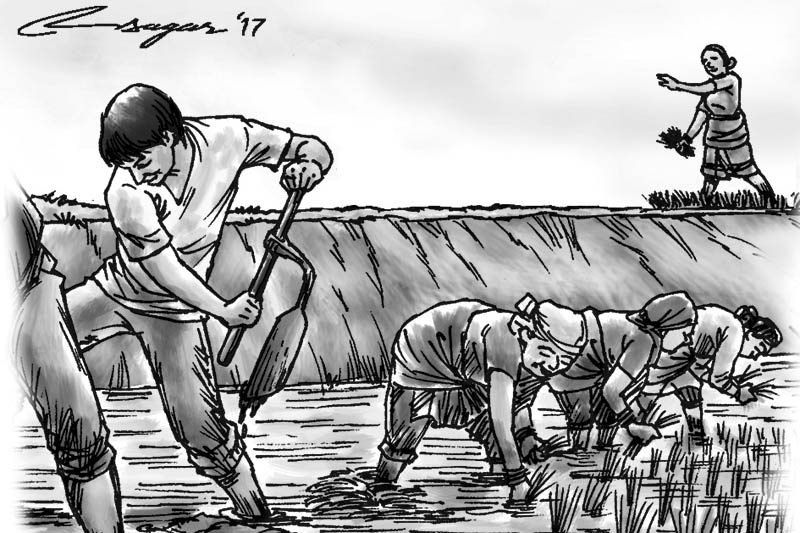Rice and food security: Serious constraints
Rice production is facing serious constraints including a declining rate of growth in yields, depletion of natural resources, labor shortages, fallow land, gender-based conflicts, institutional limitations and environmental pollution
The theme of this year’s 14th National Rice Day is “Double crops rice promotions, enhance economic motions. “ Rice is one of the most important and number one cereal crop plus staple food in Nepal.
Not only is rice a key source of food, it is also a major employer and source of income for the poor. There is 50 percent share of rice in total food grains. Nepal’s economic growth depends upon rice production.
As per the preliminary estimate of Fiscal Year 2016/2017, the rice crop was grown in 1.553 million hectares with the production of 5.230 million metric tons and the productivity was 3.369 t/ha. Rice yields are low and large yield gaps exist between what farmers are harvesting in their rice fields and what has been demonstrated by research.
The twenty year agriculture perspective plan (APP) of the government had also given priority to rice. Rice contributes nearly 21% and 7% to the agricultural gross domestic product and GDP respectively and provides more than 50% of the total calories requirement of the Nepalese people.
There is less possibility of bringing more area of land into rice production. We have to increase the productivity per hectare per day by any means. The promising technologies generated by agriculture research play a pivotal role. Nepal so far has released and registered more than one hundred rice varieties with complete package of practices within a span of fifty years.
The coverage by improved varieties in Nepal is 94%. The modern varieties can express their yield potentiality only when recommended packages are practiced. Quality seeds alone can contribute a 15-20% yield. Seed selection can be done by following the specific gravity principle as practiced by 100% of the Japanese farmers.
Early paddy and Boro (winter) rice can be used for increasing rice yield by utilizing higher intensity of solar radiation. The system of rice intensification (SRI) is the other agronomic manipulation which can increase the rice yield. However, we should not forget the environment-friendly and sustainability issues while increasing the productivity and production.
In Nepal, rice, maize, wheat, finger millet, barley and buckwheat are taken as food crops. Among these too, rice, maize and wheat are still the predominant ones which occupy about 3.17 million hectares. Rice is one of the most important cereal crops in Nepal. Food security, nutrition security, water security, profitability and sustainability are equally important.
Agricultural technologies can reduce poverty, increase profitability and improve quality of life. Not only is rice a key source of food, it is also a major employer and source of income for the poor.
As per the final estimate of Fiscal Year 2016/2017, the rice crop in Nepal was grown in 1.553 million hectares with the production of 5.230 million metric tons and the productivity was 3.369 t/ha. The total food production in FY 2016/2017 is 9.741 million metric tons.
When we review the past 7 years, the food balance of Nepal is showing a positive trend but on an average we are importing rupees two billion worth of rice every month. We eat more than the government’s estimate. Rice is also a versatile crop which can grow in almost all the agro-ecologies and varied environments.
Globally, rice is the staple food for more than half of the population (3.50 billion), employs one billion people, and rice farms cover around 150 million hectares – more than any other crop. Rice is cultivated in more than half of Asia’s cultivated lands.
The latest world rice production is 482 million tons. Most of the world’s poorest and least food-secure people live in rice-producing Asia. Rice production is arguably the most important economic activity on the planet. Now, there are challenges for growing more rice on less land using less water, less labour, and fewer chemical inputs.
In 2001, the world was not food secure because the grain stockpiles were sufficient for 59 days, 26 days in 2008 only and not for 70 days, which is thought to be food secure. People have the right to food too. Food security, nutrition security and food sovereignty are mentioned in Nepal’s constitution.
Generally half of the country is in food crisis i.e 38 out of 75 districts are thought to be food deficit in Nepal. Nepal’s population as well as food grains has doubled after 30 years.
Food crop yields are low and large yield gap exist between what farmers are harvesting in their rice fields and what has been demonstrated by research. So, there is the need to meet the growing food demand by developing/practicing appropriate technologies.
Rice production is facing serious constraints including a declining rate of growth in yields, depletion of natural resources, labor shortages, fallow land, gender-based conflicts, institutional limitations and environmental pollution.
Overcoming hunger, poverty and malnutrition while protecting the environment requires collective action by all stakeholders.
The diversity of the regions, peoples, and resources connected within the world’s rice-based
systems requires a diverse approach to global rice-based development that includes participation from the local to the international level. Our indigenous, heirloom varieties are the insurance against food insecurity.
Basnet is a retired senior rice expert at Nepal Agricultural Research Council (NARC)






